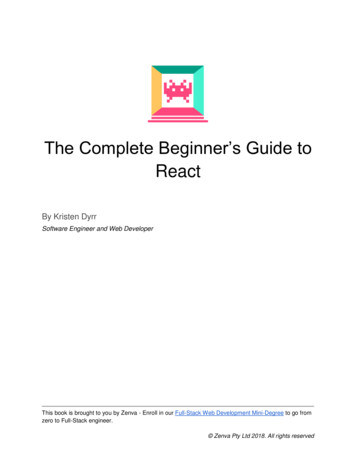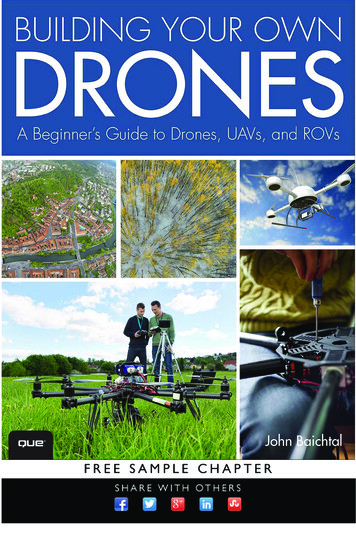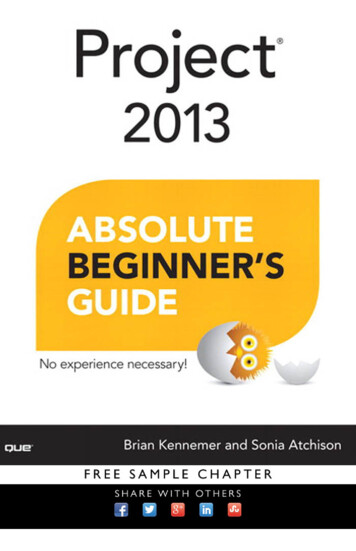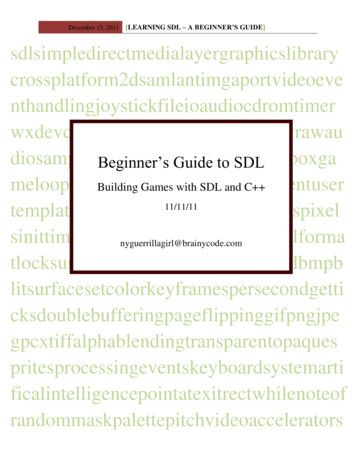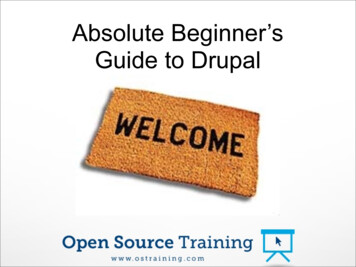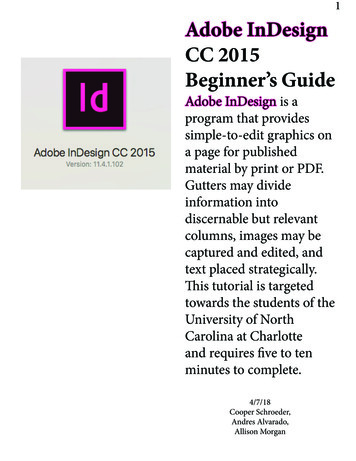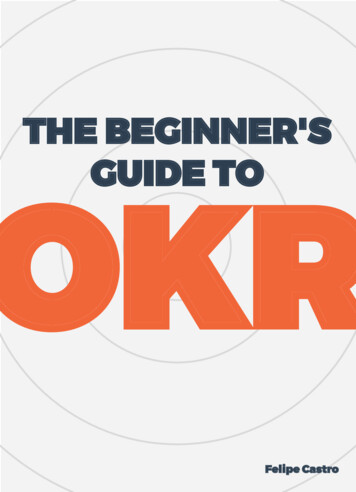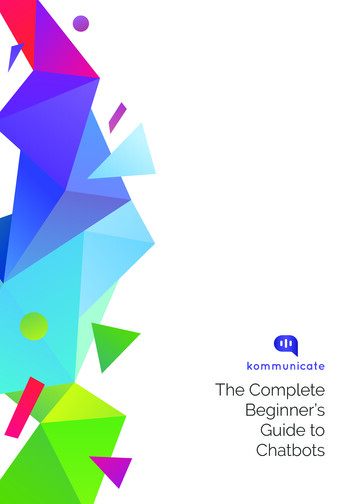
Transcription
The CompleteBeginner’sGuide toChatbots
IntroductionRollback a couple of years, and the first thing that must have come toyour mind, when you read mobile-first was perhaps apps. And no doubt,apps have given extensive leverage to businesses looking to explorenewer markets and attract different classes of customers. But come 2017,we’ve all been seeing signs of app usage and growth plateauing.So does this indicate the imminent death of mobile apps and a doomsdayscenario for mobile-app businesses?Well not necessarily, the key here for businesses is to evolve astechnology does.One such technology that is being touted as the one to replace mobileapps and websites is that of AI-powered Chatbots.Now bots are at a nascent stage and most people don’t even know whatthese bots are. Whether they can truly fulfil their potential is there to beseen, but one thing that is certain is that they can’t be ignored anymore.So if you are wondering what these bots are, why so much fuss aroundthem, what can they actually do and how to build one - I will urge you toread more. And by the time you finish reading this article, you might justbe as crazy as I am about these super powerhouses.Kommunicate www.kommunicate.io
What is a Chatbot?Chatbots are your mechanised pals, powered by a set of rules and someartificial intelligence, that you can interact with via a chat interface.Essentially they can be looked at, as automated systems that resideinside your messenger apps (Facebook, Slack, In-app Messenger of yourapps etc.). They are designed to imitate human conversations and carryout pre-defined actions, based on voice commands and/or text inputs.Let me help you visualise with an example:If you wanted to book hotels for your next travel pursuit, typically youwould: First visit one of the travel search marketplaces like Makemytrip Feed in the location and duration of stay Set other filters like type of hotel & no. of rooms required Then shortlist the best available option And finally make the bookingNow if one of these travel planning marketplaces decides to make a bot,you can then make and manage your bookings by simply telling the botyour requirements. It would ask you all the relevant questions and youjust need to answer and that’s it. The bot will fetch the best results basedon your preferences and assist you in making your itinerary.Instead of browsing a website, this interaction mirrors a typical retail pointof sale moment where you receive personalised service based on yourunique requirements.Kommunicate www.kommunicate.io
With chatbots you have endless possibilities and preparing your travelitinerary is just one of them. I guess you must be wondering about whatelse can a chatbot do and how businesses can leverage them to improveuser-experience.Well I suggest you to scroll down and read on as the next section isdedicated to the various purposes that chatbots can serve.What can they do?Soon there will be a chatbot for everything, from pizzas to flowers and forevery other noun. Does that sound like a far cry to you?Well Gartner recently reported that by 2020, 85% of customer interactionswill be managed without human.“By 2020, customers will manage 85% of theirrelationship with the enterprise withoutinteracting with a human.Gartner PredictsNow whether there can truly be a bot for everything or not is there to beseen, but one certain thing is bots have entered our lives and are leavingno time soon.Some of the most popular use cases that bots are serving and assistingtheir human counterparts in are described below: Bots as sidekicks to customer support agents:There had been many apprehensions against the popular belief that botscan one day replace customer support agents. Can they or can they not,I believe they can’t because they lack the empathy and sensitiveness ofa human agent. But what they can definitely be are assistants to thesesupport agents and do the simple tasks like answering FAQs, suggestinghelp articles and routing queries.Kommunicate www.kommunicate.io
Chatbots in Banking:Accenture in a recent report said that 76% of all banks surveyed, believethat in the next three years majority of them will deploy AI interfaces asthe primary mode of interaction with customers. Testimony to this belief isthe fact that leading banks have already started rolling out their bots. Forexample: HSBC has made customer support a 24X7 affair with their virtualassistant ‘Amy’ The updated version of American Express’ Amex Bot will allowcustomers to query any information regarding their card and account Masterpass enabled bots by Mastercard creates a seamless shoppingexperience within FB Messenger. It allows customers to transact withleading brands like Subway, Freshdirect and The Cheesecake Factory,all without leaving Messenger. Commerce Bot:As commerce moved from retail to online, it opened up a lot ofopportunities for e-tailers. Chris Messina touted the year 2016 to be theyear of conversational commerce, and e-commerce companies havejumped onto the bandwagon. Chatbots have allowed them to cater to thecustomer’s need for instant gratification in a number of ways: Shopping Bots like mySimon, queries across various merchants andreports back with product prices and descriptions. Concierge Bots like Operator, enables users to browse curatedproducts and make a purchases. Bots like CelebStyle, allow users to find products based on thecelebrities they admire. H&M’s bot learn from each customer’s preference by combining data,and then makes personalized recommendations in a multiple choicefashion.Kommunicate www.kommunicate.io
Travel Concierge:In the opening example of the article, I have demonstrated how chatbotscan help you prepare your itinerary when you are planning your next trip.Major players in the Travel and Tourism marketplace have adopted thedisruption and rolled out bots for different use cases: Pana is a virtual travel agent, where users get access to human travelagents and a sophisticated chatbot. Copa Airlines’ Web-based chat bot Ana, answers simple questionslike what destinations Copa Airline flies to and what Copa’s baggageallowances are. HelloGbye is the closest that comes to what bots can one day be. Youcan just tell the bot your travel requests (like how you do with Siri) andit will handpick and tailor make the the resulting options for you.Kommunicate www.kommunicate.io
Chatbots for Learning:Leslie is a chatbot, that can help you learn English. She can define words,provide synonyms and antonyms, translate words, explain grammar anddo many other things. Chatbots for Sales & Marketing:Your sales team is made up of humans and that’s a good thing, but sadlyhumans can’t work 24X7. That means a missed opportunity on capturinga lead. Chatbots like Driftbot, can plug the gap by engaging users withwelcome messages, answering simple questions, qualifying them andfinally passing them to a qualified human agent. Chatbots as your friend:Chatbots like Xiaoice and Mitsuku are more like personal companionsthat you can simply talk to.As you can see the possibilities are endless with chatbots. It is possible tobuild anything imaginable.But is it worth investing the time and effort that it takes to build one. Sureit looks cool and super advanced, but will it be a forerunner or fade awaylike any other fad?Why Chatbots Can Be, What Theyare Touted They Can Be?Chatbots have existed for years before going mainstream. One of themany reasons for taking them seriously is they stood the test of time.However several recent global trends have given relevance to chatbotsand made way for a once-in-a-decade paradigm shift.Kommunicate www.kommunicate.io
1. Messenger Apps overshadowing Social Apps:Messaging is the native UX of mobile and no wonder the Top 4 Messagingapps have come out as the preferred means of communication on mobiledevices.Now you would like to build your business where your users are, and itis clear that they are inside messenger apps. Typically a user would alsoexpect to be able to access all of a business’ services inside messengerapps.Now Chatbots which reside inside these apps and have the capability toimitate natural human interactions, will be the outlet for users to interactwith your business.Kommunicate www.kommunicate.io
2. App Fatigue:Let me explain this with an example; only 16% of Starbucks customersuse their mobile app, despite all of Starbucks’ promotion tactics. Nowit goes without saying that companies with lower brand equity andresources will be receiving even poorer results.The reason; users don’t like to find their way across tiny pixelated mobilescreens to get their job done. They would anyday prefer a simpler flowthat can be navigated with voice or text commands, and precisely that’swhat Chatbots are there for.3. Reduction in Development/Maintenance Cost:Chatbots are server-side applications with minimalistic UI, therefore thecosts and efforts in development and maintenance are considerably less.Major tech giants have also developed sophisticated bot frameworksto support this paradigm shift. This not only has reduced costs, but alsomade available cutting-edge technologies like AI, NLP and SpeechRecognition for Bot Development.Companies like IBM & Microsoft have invested heavily on developingadvanced bot frameworks. Also major messenger platforms likeFacebook, Skype, Slack and their likes have approved the release of bots.The very fact that major tech giants have embraced bots, strengthensthe belief that chatbots are the future of business-to-customercommunication.“Well that is all great! But how do I build one? It’s a completelynew technology with limited documentation, wouldn’t it gettricky when I sit down to build Artificial Intelligence into mybot?”Trust me; it’s not all that daunting a task, and in the next section I have gotyou covered for all the difficulties you might face.Kommunicate www.kommunicate.io
How to build chatbots?Before we move into how tobuild chatbots, it’s important tounderstand the different types ofchatbots that are there.The first kind are.Chatbots that function basedon rules:They can only be as smart as theyare programmed to be. These botswork on a specific set of rules, andanything that comes beyond itspurview it fails to act upon.The second kind of bots, which have a brain of their own are.Chatbots that runs on Machine Learning:They are backed by Artificial Intelligence and grows smarter with time.These bots have the capability of processing natural human languageand act accordingly.Now, let’s get back to building a bot.Before you set out to build a bot, it is important to note that the trickything about building a bot is more of an user experience issue, and notwriting codes.Typically to build a chatbot, one needs to:1. Identify the problem it is going to solve, and design a conversationaluser flow to solve it2. Choosing the platform where the bot will reside (Facebook Messenger,Slack, In-app Messenger etc.)3. Server setup to run the bot fromKommunicate www.kommunicate.io
Now in order to configure the bot to drive a consistent conversationalflow and assist the user, one should find the answers to these 3 questions:1. What’s the user’s goal?2. What’s the bot’s goal?3. How to handle unexpected input?Finding answers to these questions and incorporating the learnings intodesigning the conversational flow will give your bot a human outlook andsafeguard it against unforeseen situations.Once the overall conversational flow is designed, the next step is tochoose a platform for the bot to reside. Typically it would be one of themajor messenger platforms, or the in-app messenger of your application.In order to integrate your chatbot within social messengers, mostcompanies have detailed documentation guides which are listed below: FacebookSlackTelegramKikDiscordThe penultimate step is choosing a solution to build the bot. Mainly theseare of two types:1. Development (non-coding) platforms, for people like me who can’treally code2. Code-Based Frameworks, which gives you a lot more flexibility,deeper level analytics and the advantage of AI incorporation.Below is a list of some of the most popular solutions of either categories,accompanied by their salient features.Kommunicate www.kommunicate.io
Development (non-coding)platforms Chatfuel: The platform is for building Facebook Messenger bots, andallows you to build and launch one within 7 minutes. The platformsupports content cards with the option for easy checkouts. You canalso set up an FAQ or broadcast notifications to followers. Botsify: Botsify has a drag and drop interface that helps you designtemplates easily. It supports analytics integration to give you insightsabout what people are talking about. It also has a machine learninginterface so that you can continue training the bot. Motion AI: Hubspot recently acquired Motion AI with the aim to enablebusinesses better engage, convert, close and delight their customersacross every channel at scale. Flow XO: They support integrations with over 100 modules andservices to allow you to be where your customers are. Microsoft QnA maker: As the name suggests, QnA maker allows youto convert your FAQs to a bot in minutes. This can be done simply byfeeding in the URL of you FAQ page, and the next time your users lookfor any help the bot will be there to help them with the right answers.Other such platforms are Recast AI, Bottr, Chattypeople, Botkit etc.For more details into non-coding platforms read this blog on 14 mostpowerful platforms to build a chatbot.Kommunicate www.kommunicate.io
Code Based Frameworks:Building a bot using frameworks, requires working knowledge ofprogramming languages. However the bots built hence, has a brain oftheir own. They have the ability to store data and learn from it, so much sothat with time they can imitate human interactions by processing naturalhuman language.Now, when you set out to build a bot using one of these frameworks(Details below), you will have access to a set of predefined functions andclasses that would help in faster development.Below is a list of Bot Development frameworks and their salient features:1. Microsoft Bot Framework: They provide all the ingredients to build,connect, deploy and manage intelligent bots. Bots built on MicrosoftBot Framework can be deployed on any website, app and also onmessengers like Slack, Facebook Messenger etc.Running on Microsoft’s flagship Azure, it provides an integratedenvironment that’s purpose-built for bot development with BotFramework connectors and BotBuilder SDKs. It also supportscognitive intelligence that enables the bot to see, hear and interpret inmore human ways.2. Facebook Bot Engine (Wit.ai): Wit.ai provides APIs that can processNatural Human Language, which can be in the form of both text andvoice input. Upon processing this input, the Bot engine gauges theuser’s intent and executes the intended action.Wit’s dashboard allows you to manage the entire conversationflow by means of what they call it, a Story. Every Story on Wit startswith understanding human intent, based on which the Bot sendsa subsequent message to the user and moves them to a suitablepoint in the story. The penultimate step in the story is the executionof a suitable Action, which can be anything from ordering a pizza tobooking an Uber.Kommunicate www.kommunicate.io
3. Dialogflow (Api.ai): Api.ai allows you to create engaging voice andtext-based conversational interfaces via which your users can interactwith your product. The platform is a favorite among mobile appdevelopers and developers in the IoT space.In order to make it’s conversational UI a lot more context-aware, Api.ai has pre-defined domains including those of various IoT categories.This means the platform knows ahead of time what domain anydefined entities or intent applies to. This allows the system to tap intoits existing library related to any particular domain.Developers can also describe their own interactions and scenariosand the platform will seed the same into its library to give you a moredeveloped and robust conversational UI.Well saying all that was easy, but I won’t just leave you there. In the nextsection I have a detailed step-by-step guide on how you can build yourfirst bot. For the sake of this guide I have created a project on DialogFlow,and will be drawing inferences from it in the course of this article:Tools and Technology Used: Dialogflow: Bot framework to create intelligent chatbots, which youcan then integrate with your apps. Node.js : To define the fulfilment logic, which eventually processes thedata. Kommunicate chat as a service: Chat Interface to query the bot anddisplay the resulting output.Kommunicate www.kommunicate.io
Project Description - RepoFinderRepoFinder helps you find open-source development libraries fromGithub, based on your input.Step 1 - Creating Agent:The first step is creating an agent, which essentially is the bot you arebuilding. You can create one through the console by following theseinstructions. In our case, we’ve named it RepoFinder.Step 2 - Creating Intents:Next you will have to create Intents. Intents basically help the botperceive the user’s input and decide the subsequent action. Intents canbe created both from the console or by calling APIs.DialogFlow by default gives two intents: Default Fallback Intent, DefaultWelcome Intent.More Information on creating Intents is here.Step 3 - Creating Entities:Once Intents are created, you need to define entities. Entities arepowerful tools used to extract parameter values from the user’s query.Any actionable data that you want to get from a user’s request, shouldhave a corresponding entity.Kommunicate www.kommunicate.io
Consider our agent RepoFinder. The user says “Tell me the best Chat SDKon GitHub” - this should tell the agent that the user needs some info onChat SDK.So how do you configure the agent to do it? Well, for each userexpression mapped to an intent, the agent needs to figure out therespective input that the user wants info about. This, the agent does withthe help of Entities.So for each intent that you create, every user expression should containa corresponding entity, which your bot agent needs to figure out. Now bydefault, the agent can’t do that - you need to train it to do so.Kommunicate www.kommunicate.io
Step 4 - Training Agent:DialogFlow provides a training tool that allows you to add annotatedexamples to relevant intents in bulk (see screenshot below). It helps toimprove the classification accuracy of agent.Here you will also receive a log of all the queries sent to your agent andwhat the agent responded in return. This is very useful if you tell youragent something and it responds with an output you don’t like. It can alsobe helpful if you realize later on that you forgot a synonym of an entityand users are using that a lot, then you can go and tell your agent what todo in that case.Step 5 - Actions:Now your bot is all set to function. Every time it receives a query, it willfirst capture the intent and then extract the entity. The next step is togenerate a response, which the user is ideally seeking. This you can doby leveraging webhooks to fetch data from external sources (GitHubAPI server in our case). This you can do in the Fulfillment Section, byspecifying the webhook URL.The penultimate step is to tell the intent to use this webhook to respondwith the data that was returned from it.Kommunicate www.kommunicate.io
Integrating the project (e.g.RepoFinder) in Application/Website:The image below demonstrates the integration architecture and thesequence of information flow:1. User comes to website and asks for required library.2. Website uses Kommunicate Chat APIs to send message to applicationserver.3. Application server sends the query to Dialogflow agent.4. Agent uses machine learning algorithms to match the user’s requeststo specific intents and uses entities to extract relevant data from them thereby processes natural language to convert it to actionable data.5. RepoFinder returns the actionable result to application serverKommunicate www.kommunicate.io
A part of Response of RepoFinder look like this:{“parameters”: {“keyword.original”: “chat”,“keyword”: [“chat”]}}6. Application server call github search APIs and get the list of librariesrelated to the keyword.7. Application server then sends list of libraries back to User again bycalling Kommunicate APIs.As you can see building a Chatbot, is not really as intimidating as it mayseem. Owing to all the major developments and the extensive supportbots have seen from major tech giants, building a bot will only get simplerwith time. This coupled with mobile user’s affinity towards conversationalsystems will soon make bots mainstream.So, if you have not yet deployed a bot for your business, it’s time you startthinking of deploying one.Don’t want to build one yourself?Talk to Us and we might just have a custom bot in store foryou!Kommunicate www.kommunicate.io
“Bringing power of realtime and intelligentcommunication foreveryone with easeStanford Financial Square, 2600 El Camino Real, Suite 415,Palo Alto, CA 94306Phone: ( 1) (310) 909-7458www.kommunicate.io
Before you set out to build a bot, it is important to note that the tricky thing about building a bot is more of an user experience issue, and not writing codes. Typically to build a chatbot, one needs to: 1. Identify the problem it is going to so
